Beetles come in different colors. Red beetles are some of the most common types of beetles in popular culture as they are associated with a friendly nature.
Lady beetles are some of the most common species around the world when it comes to red beetles.
However, there are hundreds of beetles that have either a base red color or red as a secondary color as follows.
Table of Contents
1. Spotless Lady Beetle
Spotless Lady Beetles (Cycloneda sanguinea) are among the most common types of red beetles in the United States.
This species has a small size with a dome-shaped body. Its elytra are completely red albeit some Spotless Lady Beetles have an orange elytra.
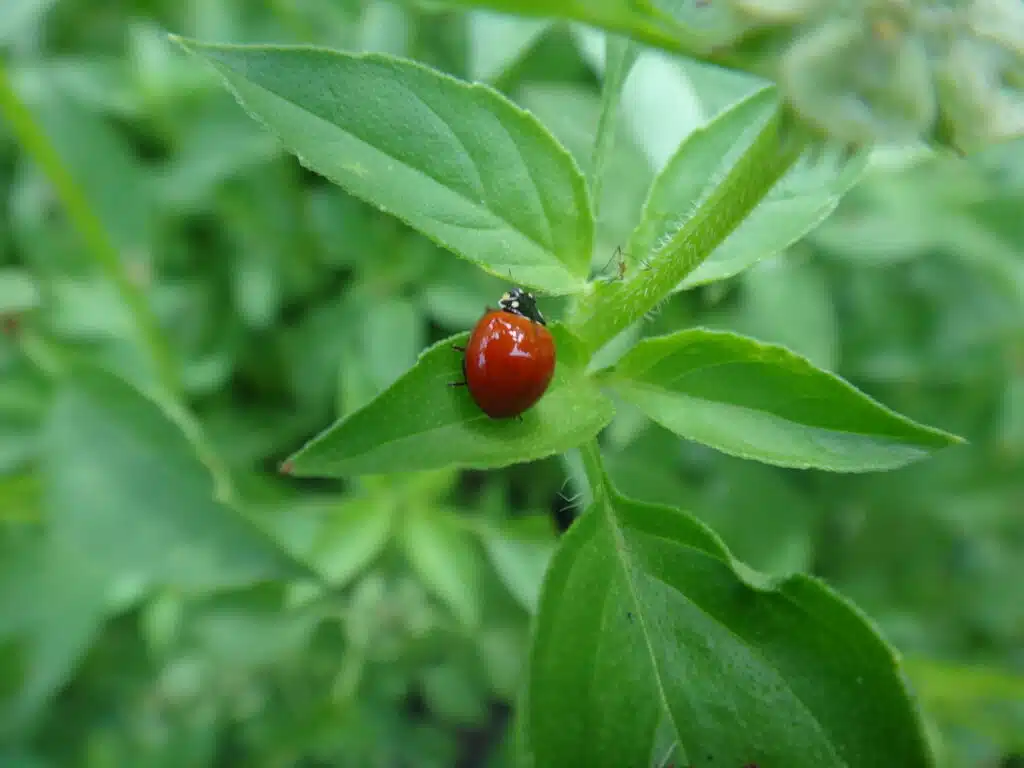
The upper side of the species is black with white spots.
Spotless Lady Beetles might be encountered anywhere around the world since it feeds on aphids. Apart from insects, this species relies on milkweed as a host plant.
2. California Lady Beetle
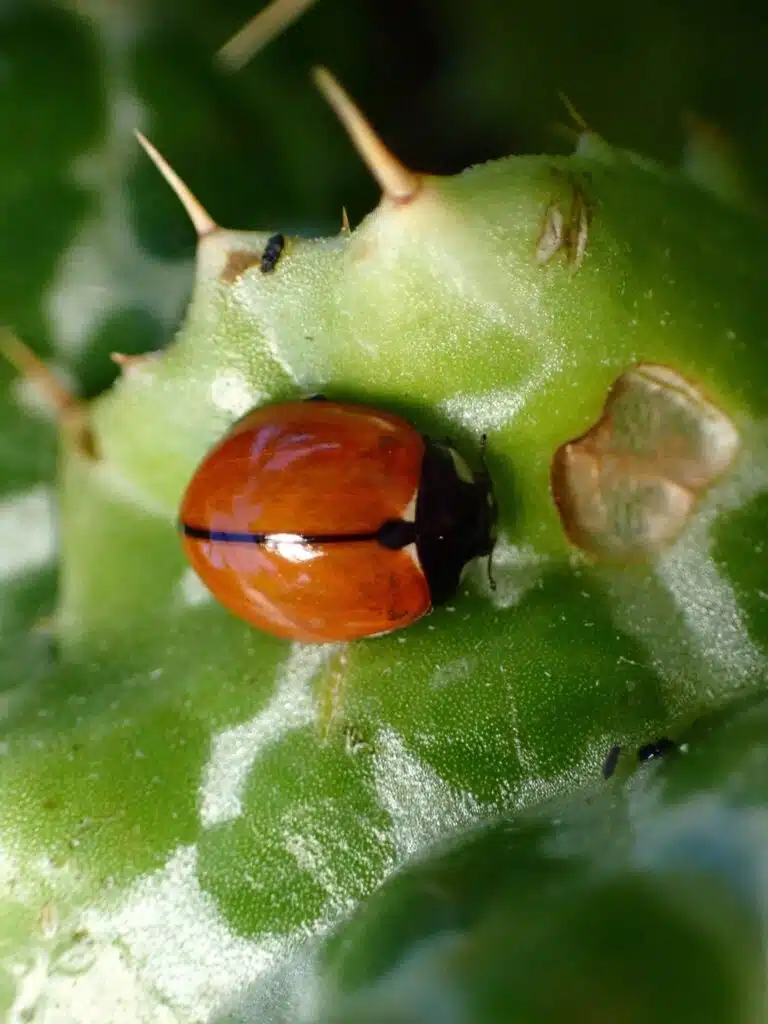
California Lady Beetles (Coccinella californica) are highly similar to Spotless Lady Beetles. As its name implies, this species is found in California.
Its range expands North considerably. The beetle can be found everywhere on the West Coast of the United States.
California Lady Beetles are among the most common species with red elytra and a black cephalothorax. The upper side of the body also has white spots, just as on the Spotless Lady Beetle.
This species might be small, red, and friendly-looking, but it’s a predator. These red beetles feed on aphids and other small insects they find on crops and in gardens.
3. Asiatic Garden Beetle
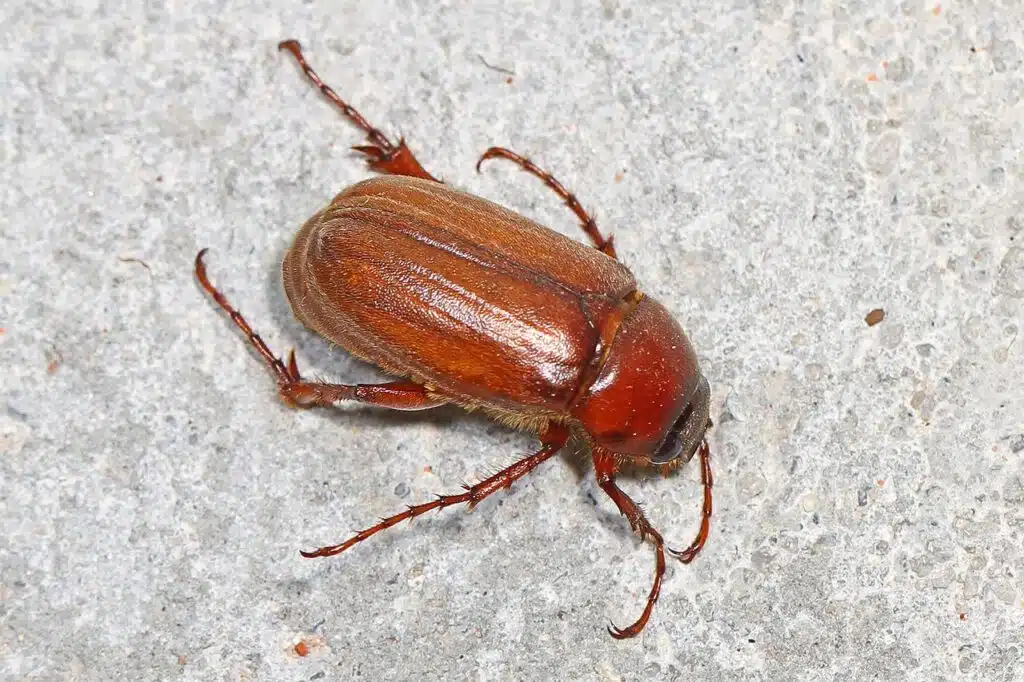
The Asiatic Garden Beetle (Maladera formosae) is an imported species to North America. It comes in different shades of red or brown and it shares the shape of a typical lady beetle.
The Asiatic Garden Beetle has a size that varies from 8 to 11mm.
Bugs of this genus have a nocturnal nature which means they don’t seem as common as they are.
The Asiatic Garden Beetle is a pest you should worry about if you grow various roses around the house.
Bugs of this genus feed on the leaves of various roses.
4. Lily Leaf Beetle

Lily Leaf Beetles (Lilioceris lilii) are some of the most common imported species to the US and Canada.
As the name of the species implies, these small beetles feed on lilies. Their damage is considerable and you need to take action against these bugs if you grow lilies in your garden.
Lily Leaf Beetles are among the most specific types of bugs with a red color. They have a dark red color with a shiny look.
These red beetles are often taken for ladybirds but they have a longer body, deeper red coloring, and a different diet. These red bugs are herbivorous.
5. Red Flat Bark Beetle
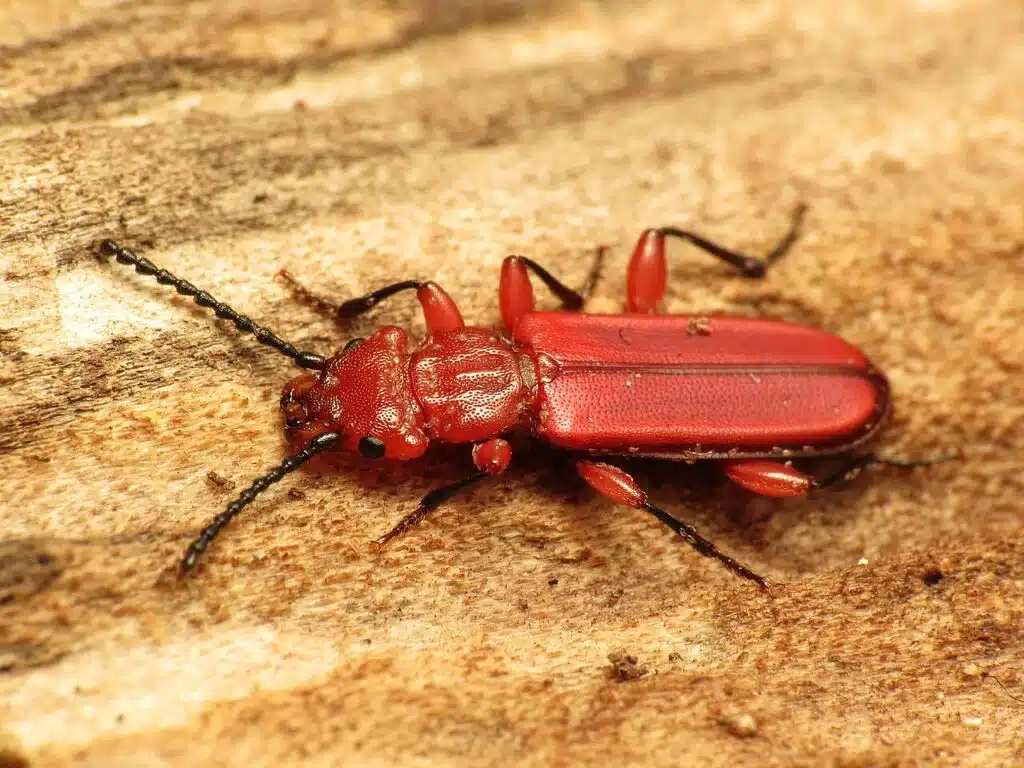
Red Flat Bark Beetles (Cucujus clavipes) are some of the most common red bugs that most people can’t see due to their secretive nature.
As their name suggests, Red Flat Bark Beetles mostly live and eat under tree bark.
These beetles have an elongated body that allows them to enter small tree bark openings.
They eat almost all types of small insects under tree bark which makes them a beneficial species to the ecosystem.
Red Flat Bark Beetles are also among the multiple species of red beetles with red head and red legs.
These red beetles might eat all types of insects but they also have their food preferences.
The larvae of other insects are preferred by Red Flat Bark Beetles as they are softer and easier to consume.
6. Golden Net-winged Beetle

This type of beetle (Dictyoptera aurora) is among the rare species with a worldwide presence that includes harsh climates.
Adapted to temperate and cold habitats, the Golden Net-winged Beetle has an elongated body and a red color.
The nuance of its red color has orange to brown undertones which means its coloring doesn’t stand out as much as the color of red ladybugs.
This species also has distinct grooves across its long wings.
You can find the Golden Net-winged Beetles at high altitudes on mountains where it lives in the woodlands. It prefers coniferous woodlands.
7. Sutured Longhorn Beetle
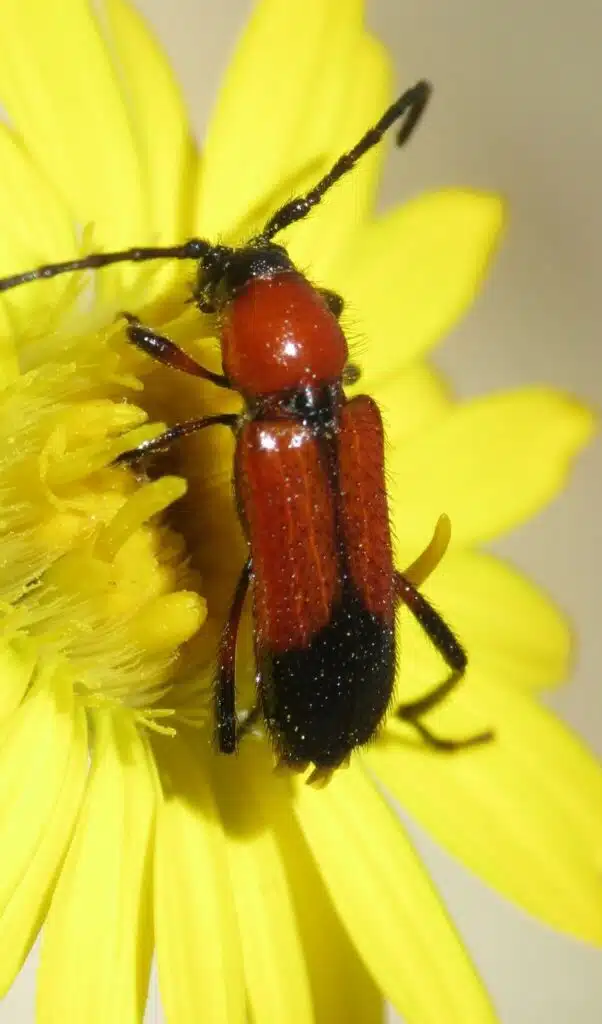
These elongated bugs(Batyle suturalis) are common around The Rocky Mountains. You can identify the species by its base red color with brown nuances.
Bugs of this genus have an elongated body shape with long elytra.
Red wings with black margins are characteristic of the species. Bugs of this genus also have red head.
Its legs and antennae are black.
These bugs are herbivorous and exclusively feed on pollen.
Preferred pollen sources include daisies and sunflowers. As a result, this type of red beetle is found at low elevations across Western North America.
8. Common Red Soldier Beetle
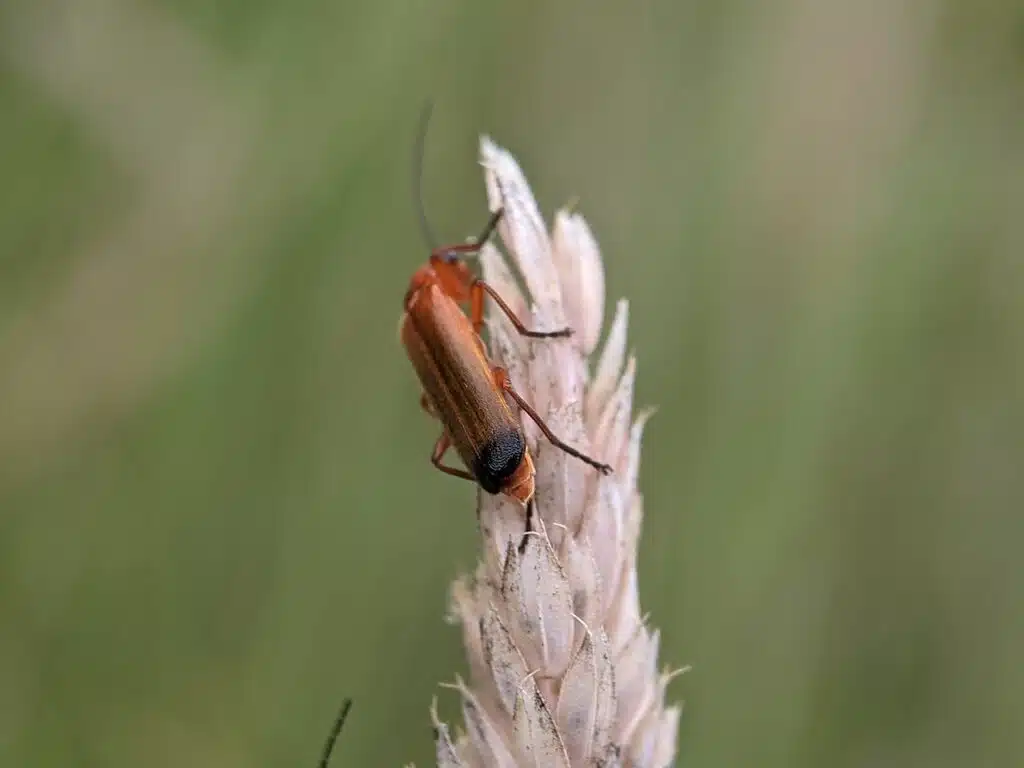
Common Red Solider Beetles (Rhagonycha fulva) are among the smallest species of red beetles in North America.
This species grows to a maximum of 10mm. It has a light red head and dark red elytra.
Bugs of this genus have black wing tips.
Common Red Solider Beetles are among the omnivorous red beetles of the United States.
They feed on pollen from a wide range of plants but they also consume tiny insects such as aphids.
Adult Common Red Solider Beetles should not be collected from the garden as they have a positive role in the ecosystem
9. Red Net-winged Beetle
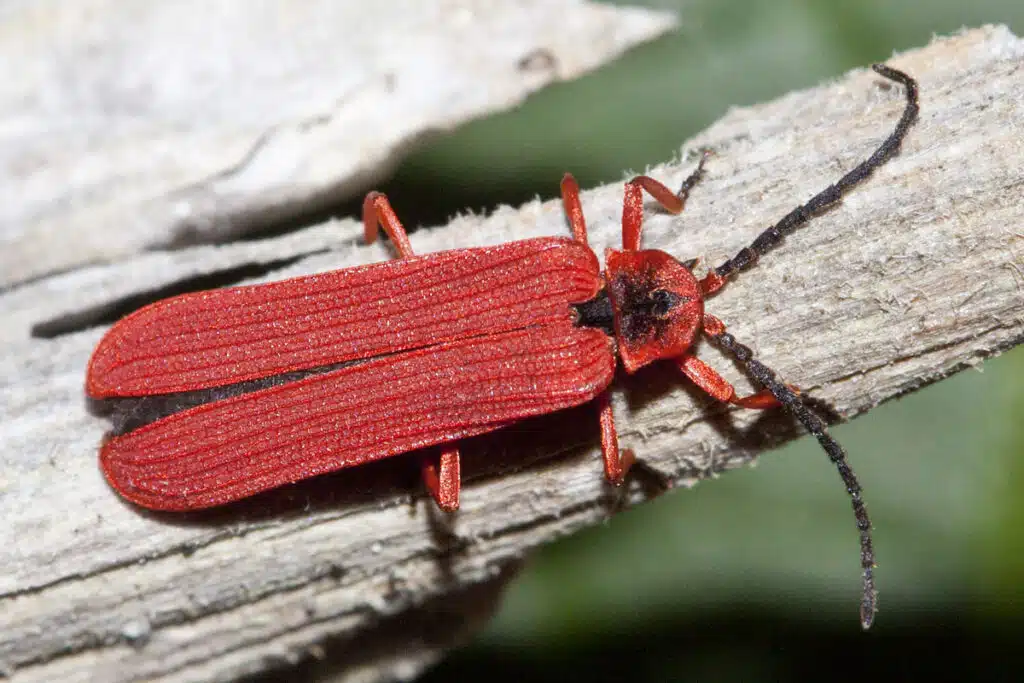
Red Net-winged Beetles (Dictyoptera simplicipes) have a matte red dorsal color. This makes it look different from shiny red beetles such as ladybugs.
The species has a red to orange color and deep grooves on the elytra that make it stand out.
Its body shape is elongated while its head is small in relation to the elytra.
The hindwings of the species are black, as is its body.
Red beetles of this genus also have black antennae and black ventral coloring.
Small black nuances are also seen on its red head.
10. Air Potato Leaf Beetle

Air Potatoes (Lilioceris cheni) are a type of yams affected by the Air Potato Leaf Beetle.
This small beetle feeds on the leaves of air potato to the extent it either hinders plant growth or it kills it completely.
Air Potato Leaf Beetles are some of the smallest red bugs in North America. They grow to an average length of just 9mm.
These small beetles have a dark red color or a red to brown color of the elytra.
The head of the species is black, as are the antennae.
Ventral coloring is shiny black.
11. Oak Leaf Rolling Weevil
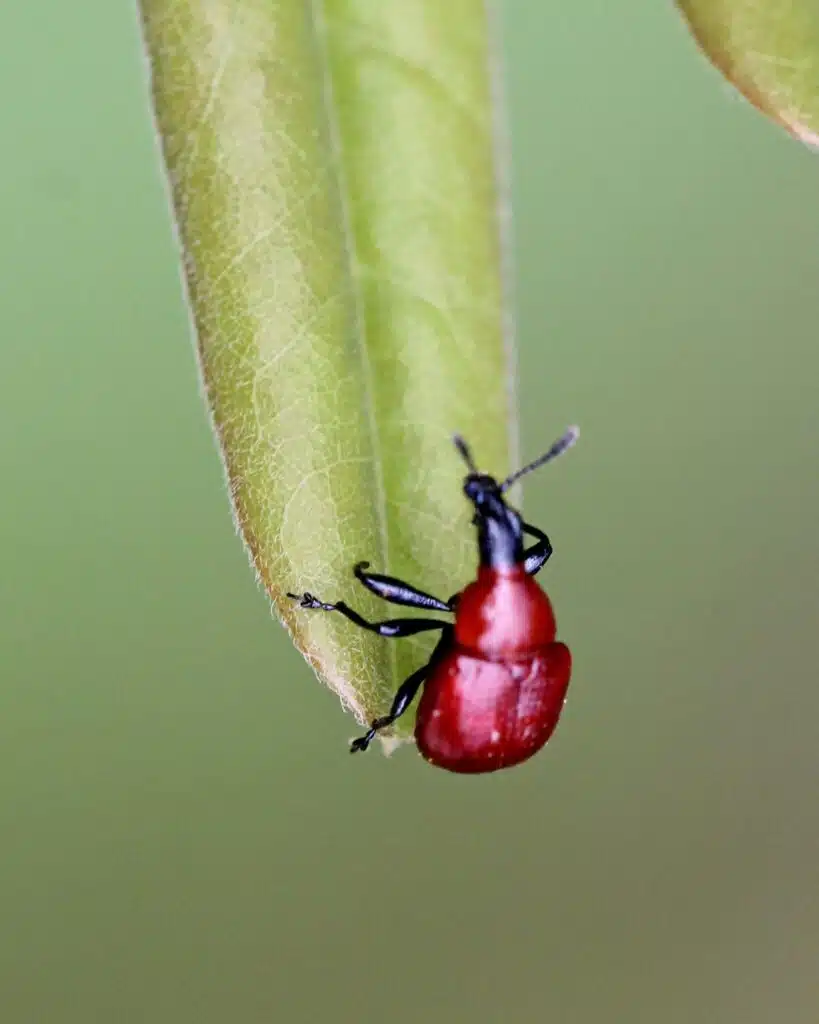
Oak Leaf Rolling Weevils (Homoeolabus analis) are some of the most dangerous oak pests in North America.
This species has been named after the tree it lives and feeds on. Oak trees are affected by this species for their larvae.
Oak Leaf Rolling Weevils roll oak leaves around their eggs so that the emerging larvae use them for food as well as for protection from immediate predation.
You can identify the Oak Leaf Rolling Weevil by its mostly dome-shaped body with slight elongation.
This species has a red to brown color, a black head, and black legs.
Unlike other red beetles, the Oak Leaf Rolling Weevil doesn’t have smooth wings. It shows small punctuations that look like holes across its elytra.
12. LeConte’s Giant Lady Beetle
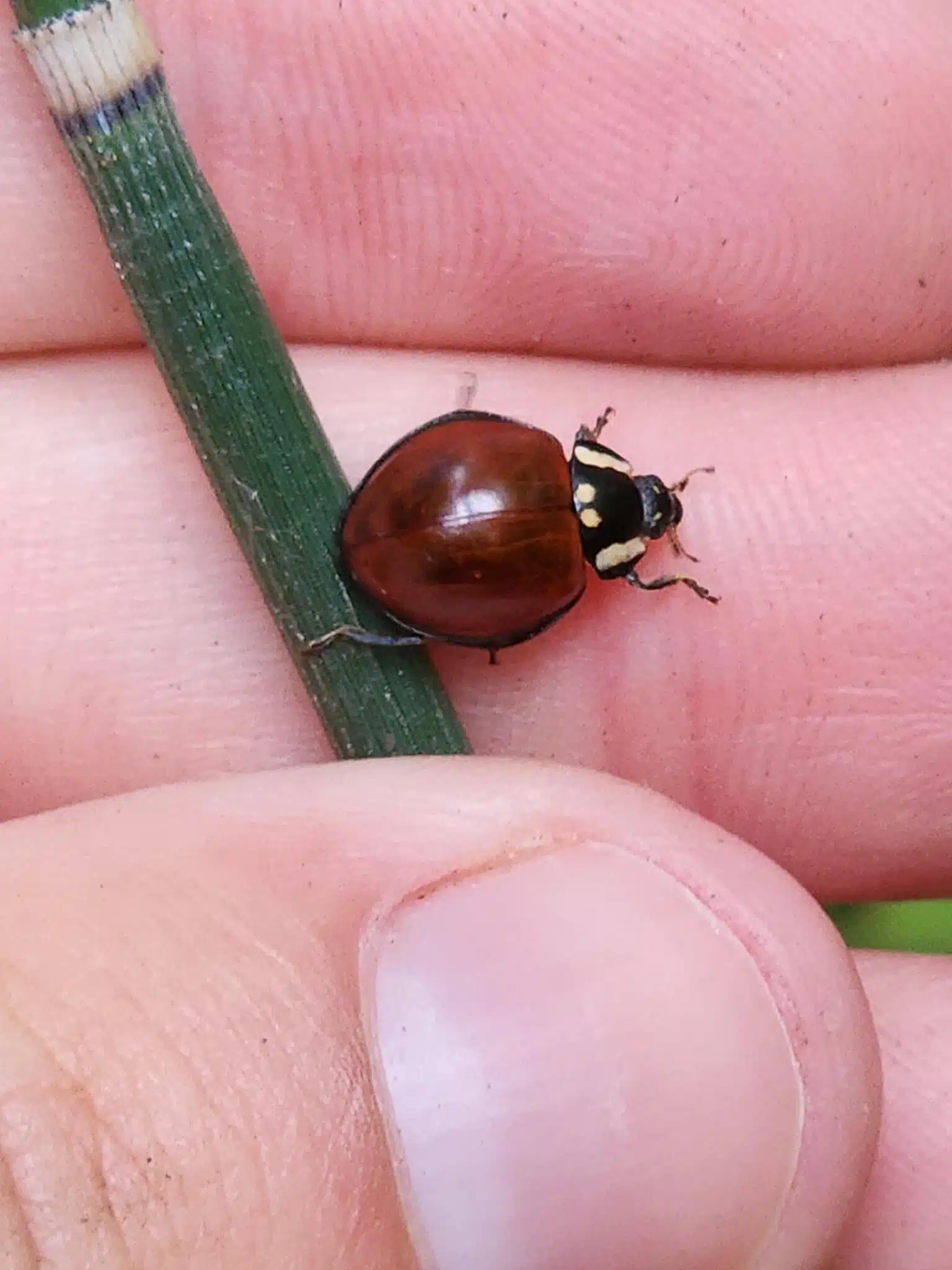
This type of red beetle (Anatis lecontei) is part of a group of tiny red bugs native to North America.
Growing to a maximum size of 7.5mm, LeConte’s Giant Lady Beetle is among the species with the smallest dome-shaped bodies in North America.
This bug has a red-brown elytra color and a black head that showcases both yellow stripes and yellow dots.
The margins of its wings are black, as is its ventral side.
While small, LeConte’s Giant Lady Beetle is a predator. It feeds on a wide range of aphids having a beneficial role.
However, this beetle is rarely seen on crops as it prefers aphids that live on trees rather than aphids that feed on cultivated vegetables.
13. Blood-winged Blister Beetle
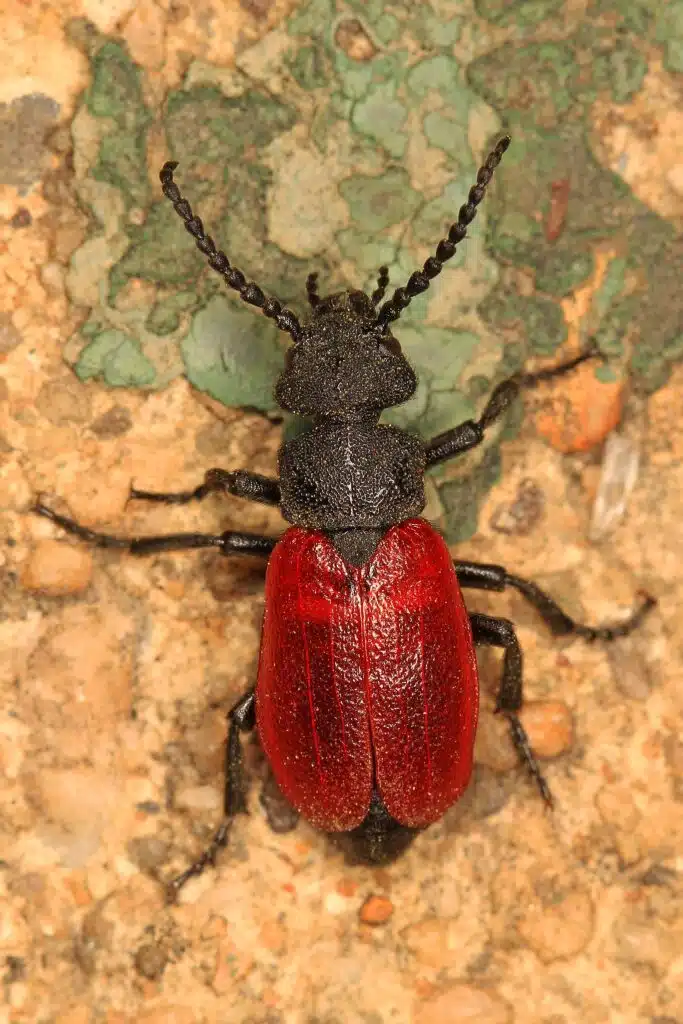
Blood-winged Blister Beetles (Tricrania sanguinipennis) are a species known for their vivid red color. Its elytra are red while the prothorax is black.
The legs and antennae of the species are black.
This species of red beetle is known to have a changing diet depending on their life stage.
Insects are often consumed by the larvae of this species. Blood-winged Blister Beetle larvae often feed on bees as a parasite which makes it detrimental to the ecosystem.
Adults of the species feed on plant nectar.
You can find adult Blood-winged Blister Beetles feeding on asters during the day.
14. Bloody Net-winged Beetle
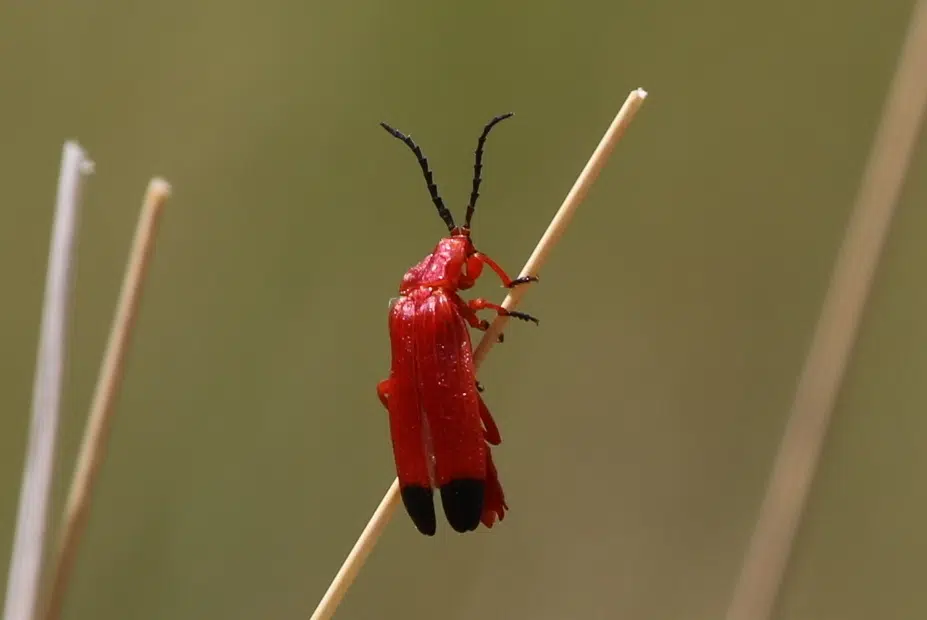
Bloody Net-winged Beetles (Lycus sanguineus) get their name from their blood-red coloring. This color is specific to most areas of its body.
The elytra of the species have a blood red color with black wing tips.
Blood red is also the color of the head and legs of the species while the antennae are mostly black.
This species is common in arid climates where it uses various plants as hosts. It’s a common sight across Southern Arizona and Southern Texas.
15. Reddish Potato Beetle
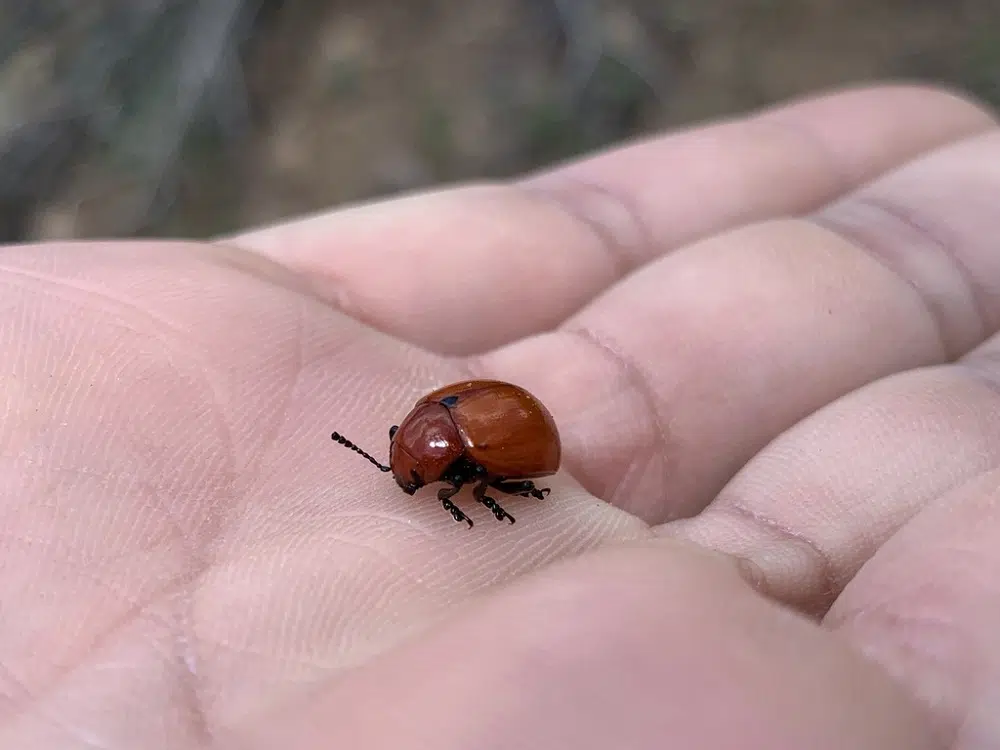
Reddit Potato Beetles (Leptinotarsa rubiginosa) are less common pests of crops in Southern US states.
This small species has a red color and black legs. The red nuance of the species is closer to the brown coloring of cockroaches rather than the vivid red coloring of most ladybugs.
The species is known to feed on a very wide range of host plants. Wildflowers are part of its diet.
However, this bug also feds on the tomato and potato leaves which means chemicals and natural repellents need to be used against it in the garden or on crops.
16. Granulate Ambrosia Beetle
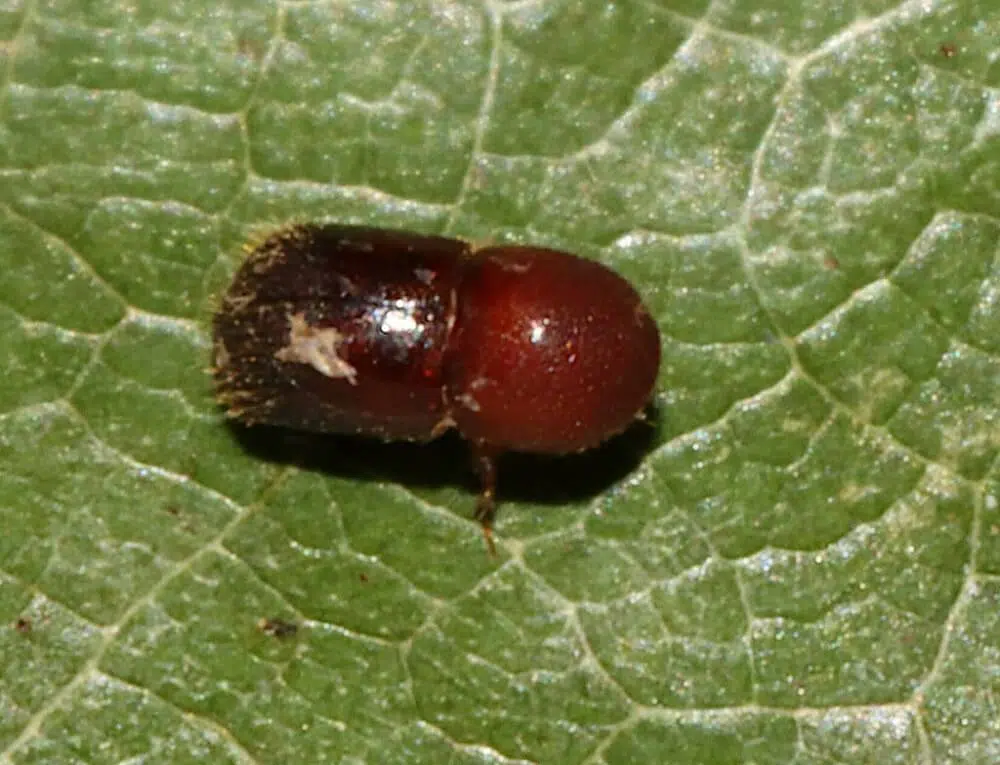
These tiny red beetles (Xylosandrus crassiusculus) are barely visible but highly damaging. Native to North America, this species is found at medium at high elevations on fruit-bearing trees and on hardwood trees.
A dark red color is specific to the Granulate Ambrosia Beetle.
Its name suggests the species only feeds on asters. However, this is only the case for the adult Granulate Ambrosia Beetle as its larvae are found on trees in gardens, parks, and woodlands.
Aspen and elm trees are among the most impacted species by the feeding habits of their larvae.
The Granulate Ambrosia Beetle larvae also feed on the stems of cherry and peach trees.
17. Red-winged Tritoma
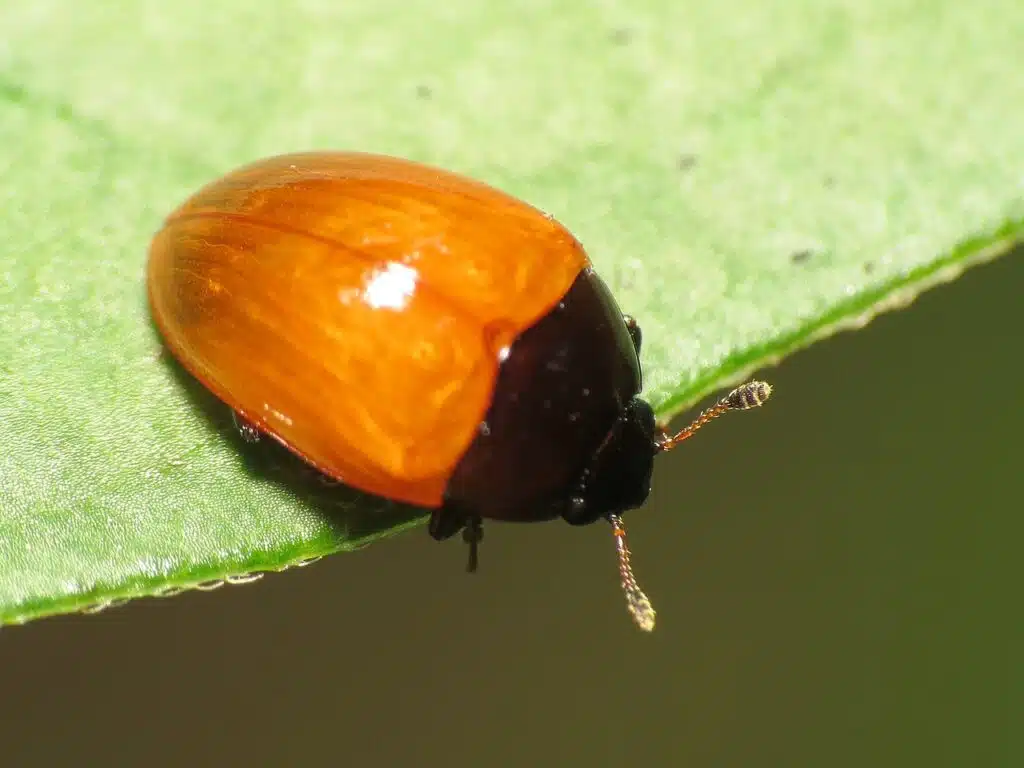
Red-winged Tritoma bugs (Tritoma sanguinipennis) are among the beneficial species of the United States.
This bug is an important pollinator as it visits one plant after another. Its most beneficial role is with the control of fungi in the ecosystem as it prefers fungi to other food.
In the absence of fungi, the red bug might also feed on plant matter, but not to a highly damaging impact.
Its elytra have a red to brown color while its head is black.
The elytra of the Red-winged Tritoma has a dome shape while its ventral coloring is shiny black.
18. Rose Curculio
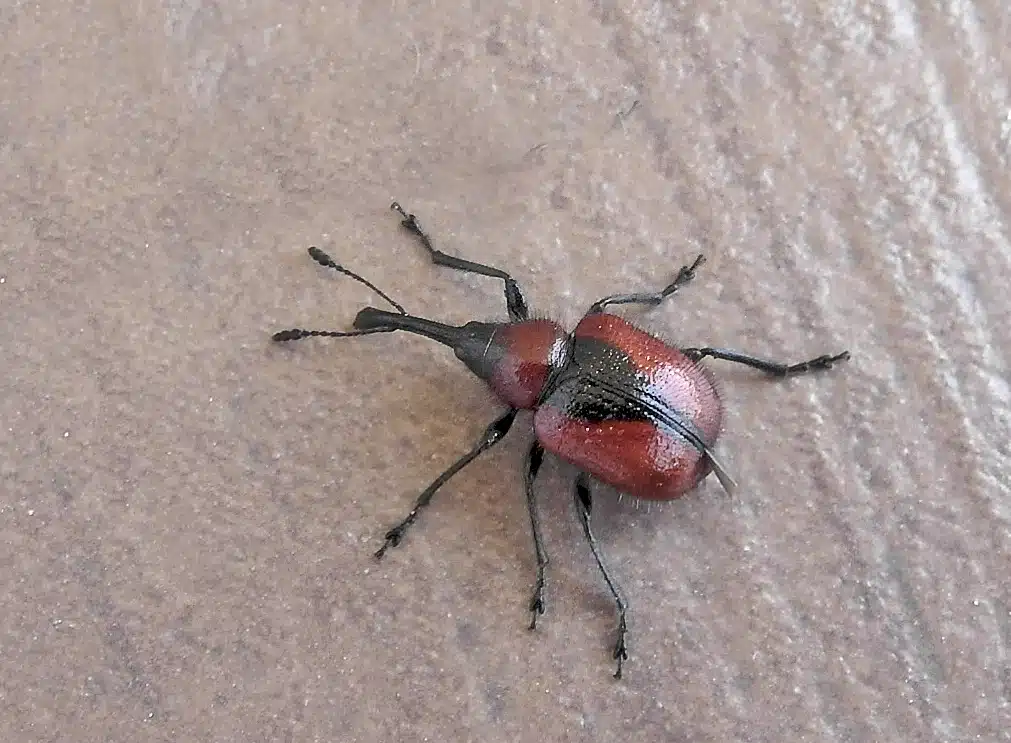
Rose Curculio red beetles (Merhynchites bicolor) have a different shape from other red bugs in the US. This species has elongated black mouthparts it uses to feed on various flowers and flower buds.
The Rose Curculio is one of the most common pests to deal with on plants of the rose family.
Bugs of this genus establish themselves on roses, directly inside flowers.
This places them in a good feeding position.
Rose curculio bugs have also been shown to establish themselves in the flowers that are already clipped.
More common on large rose plantations than in homes, this species still needs to be manually removed to avoid considerable damage to roses.
You can identify Rose curculios by their black elongated snouts which help them eat more efficiently.
These bugs have a dark red color. They also come in a brown morph.
The red coloring is specific to the elytra and the head while its legs, snout, and antennae are black.